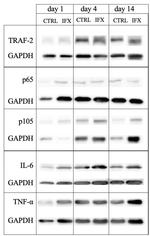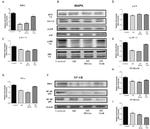Search Thermo Fisher Scientific
图: 1 / 2
NFkB p50/p105 Antibody (14-6732-81) in WB


产品信息
14-6732-81
种属反应
已发表种属
宿主/亚型
分类
类型
偶联物
形式
浓度
纯化类型
保存液
内含物
保存条件
运输条件
RRID
产品详细信息
Description: The polyclonal antibody reacts with mouse, rat, and human NFkB p50; the antibody was raised against a peptide mapping to the carboxy terminus of human NFkB p50. Members of the rel/NFkB family of transcription factors are involved in the regulation of cellular responses, such as growth, development, and the inflammatory response. They share a structural motif known as the rel homology region (RHR), the C-terminal one third of which mediates protein dimerization (2, 6, 8). Complexes of p50 (NF-kB1) or p52 (NF-kB2) are generated through the processing of p105 and p100 precursors, respectively. These are usually associated with members of the Rel family (p65, c-Rel, Rel B). The homo- and heterodimer formed through combinations of NFkB/Rel proteins bind distinct kB sites to regulate the transcription of different genes (7, 9). In resting cells, NFkB is retained in the cytoplasm bound to inhibitory proteins of the IkB family. Degradation of IkB proteins occurs with cell activation, via of variety of signals, including inflammatory cytokines and bacterial lipopolysaccharides (LPS) as well as oxidative and fluid mechanical stress. This results in nuclear translocation of NFkB and the transcriptional gene activation of proinflammatory genes (1, 9). It has been suggested that NFkB plays a role in the development of numerous pathological states. Activation of NFkB induces gene programs leading to transcription of factors that promote inflammation, such as leukocyte adhesion molecules, cytokines, and chemokines. It is also thought that there are some substances with possible anti-inflammatory effects that are also NFkB regulated. There is some evidence indicating NFkB as a key factor in the pathophysiology of cardiac ischemia-reperfusion injury as well as the development of insulin dependent Diabetes Mellitus (4, 3).
Applications Reported: Purified anti-mo/hu/rat NFkB p50 and p105 poly has been reported for use in immunoprecipitation, immunoblotting (WB), and immunohistochemical staining.
Applications Tested: Purified anti-mo/hu/rat NFkB p50 and p105 poly has been tested by immunoblotting (WB). (1:400 starting dilution). It is recommended that this antibody be titrated for optimal performance in the assay of interest.
Purity: Greater than 90%, as determined by SDS-PAGE.
Aggregation: Less than 10%, as determined by HPLC.
Filtration: 0.2 µm post-manufacturing filtered.
靶标信息
NF-kB is a nuclear transcription factor activated by various extra and intracellular stimuli such as cytokines, UV radiation, stress, in injury, and by bacterial and viral products. It is involved in regulation of various cellular events including cell growth, differentiation, proliferation, apoptosis and inflammation. NFKB1 (p50), a 50KDa functional sub-unit of NF-kB, is a member of Rel protein family. It is synthesized as a p105 precursor protein and consists of an N-terminal conserved RHD-region containing nuclear localization signal, DNA-binding and dimerization domains. NFKB1 (p50) forms homodimers or heterodimerizes with p65, forming the functional NF-kB factor. NFKB1 (p50) directs the nuclear translocation of NF-kB and is instrumental in its DNA-bidning. Pathological role of NF-kB has been suggested in AIDS, hematogenic cancer cell metastasis and rheumatoid arthritis.
仅用于科研。不用于诊断过程。未经明确授权不得转售。
生物信息学
蛋白别名: DKFZp686C01211; DNA-binding factor KBF1; EBP-1; MGC54151; NF kappaB1; NF KB; NF-kappa-B1 p84/NF-kappa-B1 p98; NF-kappaB p50; NF-kappabeta; NF-kB p50/p105; nuclear factor; nuclear factor kappa b; nuclear factor kappa-B DNA binding subunit; nuclear factor kappaB p50; Nuclear factor NF-kappa-B p105 subunit; nuclear factor NF-kappa-B p50 subunit; nuclear factor of kappa light chain gene enhancer in B-cells 1, p105; Nuclear factor of kappa light polypeptide gene enhancer in B-cells 1; nuclear factor of kappa light polypeptide gene enhancer in B-cells 1, p105; nuclear factor-kappaB p50; p50 subunit of NF kappaB; p50 subunit of NF-kappaB
基因别名: CVID12; EBP-1; KBF1; NF-kappa-B; NF-kappaB; NF-kappaB1; NF-kB; NF-KB1; NFkappaB; NFKB-p105; NFKB-p50; NFKB1; p105; p50; p50/p105
UniProt ID: (Human) P19838, (Mouse) P25799
Entrez Gene ID: (Human) 4790, (Mouse) 18033, (Rat) 81736



